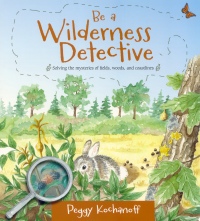| ________________
CM . . .
. Volume XX Number 2. . . .September 13, 2013
excerpt:
Young naturalists will find plenty of information about Canadian fields, woods and coastlines in this engaging nonfiction book. Topics covered include scat, galls, tortoise bugs, animal hibernation, tree rings, lichens, maple sap, fireflies, tides and sandpipers. Each chapter answers a question that is posed in child-friendly language: “Do you know what those weird growths on some plants are?” The clearly written explanations that follow also have a conversational tone. Children are encouraged to explore and engage with their surroundings. As Peggy Kochanoff says in her introduction, “You can try to solve some of the mysteries in nature, often found as close as your own doorstep. All you need is curiosity and patience. LOOK, LISTEN, SMELL and TOUCH”. The approachable writing style captures readers’ interest, as in this description of a tortoise bug: “They have a hook that they hold over their back that collects bits of poop and skin they’ve shed. They wave this big, brown glob that forms at predators to scare them off. Try touching the glob gently with your fingers and watch it wave”. Be a Wilderness Detective is a great resource for school assignments as well as being an entertaining nature guidebook for children. Highly Recommended. Linda Ludke is a librarian in London, ON.
To comment
on this title or this review, send mail to cm@umanitoba.ca.
Copyright © the Manitoba Library Association. Reproduction for personal
use is permitted only if this copyright notice is maintained. Any
other reproduction is prohibited without permission.
NEXT REVIEW |
TABLE OF CONTENTS FOR THIS ISSUE
- September 13, 2013.
AUTHORS |
TITLES |
MEDIA REVIEWS |
PROFILES |
BACK ISSUES |
SEARCH |
CMARCHIVE |
HOME |

 Kochanoff’s realistic watercolour illustrations look like sketches that have been taped into a nature journal. The pictures and diagrams are labelled and help to explain the concepts discussed. Highlighted words in the text are also defined in a glossary at the end of the book.
Kochanoff’s realistic watercolour illustrations look like sketches that have been taped into a nature journal. The pictures and diagrams are labelled and help to explain the concepts discussed. Highlighted words in the text are also defined in a glossary at the end of the book.